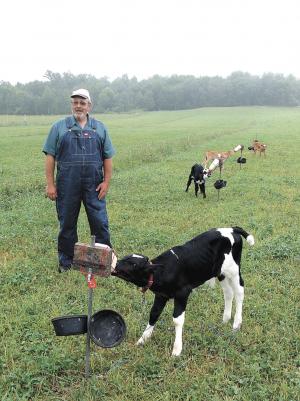2006 - Volume #30, Issue #6, Page #28
[ Sample Stories From This Issue | List of All Stories In This Issue | Print this story
| Read this issue]
Tethering Method Keeps Calves Healthier
 |
Tethering is safe and humane when done properly, they say.
Over the past four years, the couple has used this system to raise 120 baby calves with zero mortality. Even with no buildings for the young animals, which are tethered for four to six weeks between April and June, the calves thrive. According to the Abels, this method has been more successful than any other method they've ever tried.
Part of their secret is the simple, trouble-free tether stake that Melvin designed and now makes to sell.
The 4-ft. stake is made from 1/2-in. pipe (old waterline), with a 16-in. section of angle iron welded horizontally about 18 in. from the bottom. When the stake is pounded into the ground, the crossbar prevents it from spinning.
The calf wears a leather dog collar with an 8-ft. length of plastic-coated 5/32-in. steel cable attached. It's similar to a dog leash, with a snap on each end.
The couple warns that the cable should not be any thinner than this or it will likely wrap around the stake and "knot up."
The other end of the cable snaps onto a 3-in. ring that's threaded over the stake and turns freely. The bigger this ring is, the better, according to Abel, because it ensures that the calf can travel freely in any direction around the stake without the tether cable becoming twisted around the stake.
Abel adds that an area of grass under the stake should be mowed because long grass may interfere with the ring's ability to turn.
Part-way up the stake, he bolts two 8-in. dia. by 4-in. deep hard rubber pans for water and grain. Above that, Able mounts a removable wooden block (a short piece of 2 by 8), by drilling a hole in it and sliding it over the top of the stake.
The block provides a place to hang a plastic 2-quart nursing bottle for milk feedings (50/50 milk replacer and colostrum purchased from dairy farmers), using its wire harness. A covered screw in the stake keeps the block in place, preventing it from spinning while the calf nurses.
Abel charges $55 each (plus S&H) for his self-styled tethering stakes.
"Tethering calves is the smartest way to go because there's no cost for buildings, no bedding and no need to haul manure since they spread it themselves. It's extremely cost effective," he says. "We buy baby dairy-cross calves from seasonal dairymen whenever possible, and have tethered up to 40 at a time."
Abels says, if desired, his system can be used until October, when harsher weather becomes an issue.
"After a month to six weeks of tethering, we move them into milk-fed community pens with four to six calves per group for another couple of weeks before gradually starting to rotationally graze them. When they're a year and a half old, we sell them as 700 to 800-lb. feeders," Melvin says. "It was a learning process along the way, but now we have a system that works really well. You have to be patient for the first couple of days teaching the calves to drink from the bottles."
Abel says "phenomenal calf health" is achieved by isolating the animals from each other (preventing physical contact).
"Sickness can be detected and treated quickly without contaminating the other calves," he explains. "The calves weather even nasty rain storms with no problem and being outside like that keeps them clean and shiny."
During his three-month tethering period, Abel can usually run two to three calves consecutively on the same stake without moving it. The only time he needs to relocate a tether is if the area becomes too muddy.
"I got the idea for tethering calves from my son, Adam, who's a grazing specialist. He heard about it from another Wisconsin farmer who's been trying it. Apparently, it's also quite popular in Argentina."
Contact: FARM SHOW Followup, Melvin Abel, W4393 Maple Center Rd., Greenwood, Wis. 54437 (ph 715 255-8750).

Click here to download page story appeared in.

Click here to read entire issue
To read the rest of this story, download this issue below or click here to register with your account number.




